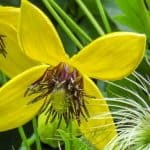Last updated on February 19th, 2022
Our site is reader supported, this means we may earn a small commission from Amazon and other affiliates when you buy through links on our site.
The correct pruning of a clematis encourages more flowers and stronger growth. It, in effect, keeps your plant from getting out of control in terms of its growth and manifesting in the form of tangled stems and flowers that are too high to see with bare stems at the base. Group two clematis flower early spring but you can also get a second flush of flowers on new growth in late summer if pruned correctly. Ideally, you prune late winter or early spring and again immediately after flowering to promote the second flush of flowers.
If you have a clematis that flowers in the late summer then you probably have a group 3 clematis which you can learn how to prune here.
Type of clematis
There are three types of clematis and they bloom on different wood, some bloom on the wood from the previous season and others bloom on new wood, which dictates when you can properly prune.
Those clematis that fall into group two are the large-flowered hybrids and these will produce their first blooms between May and June and some varieties will also produce a second flush of flowers in the late summer. With this in mind, this type of clematis should be pruned late winter after flowering or early spring just as new growth begins. They can then be pruned lightly for a second time immediately after flowering to promote the second flush of flowers.
Quick Facts:
| Flowering Times | May and June, and often late summer. |
| Pruning Times | Late winter through early spring and again directly after the first flowers of summer. |
| Difficulty Level | Moderate/Easy – Don’t prune too hard as this can mean fewer flowers. |
Clematis that you prune which are in group 2 will produce flowers (as mentioned) between May and June and they do so on short shoots that develop from the growth of the previous season. There are certain varieties that might flower a second time at the end of summer and the second round grows on the new growth from the current season.
Some examples of the types of clematis that are group 2 include:
- Belle of Woking
- Nelly Moser
- Beauty of Worcester
- Doctor Ruppel
- Edith
- Sieboldiana
- Jackmanii Alba
- Show Queen
- The President
- Royal Velvet
When to prune
As mentioned, those that fall into this category should be pruned in late winter or early spring. February is the perfect month and then again after that first flush of flowers at the onset of summer.
How to prune
The purpose of this type of pruning is to create and eventually maintain the framework of your pre-existing clematis to stimulate new growth in such a way that maximises the flowers you receive. If you have a newer plant you will need to prune it more often so that you can get the flowers to grow beyond just the tips. If your plant has established three or four healthy stems all growing out directly from the base, you don’t need to worry about this as much, but if it hasn’t, then make sure you prune it back hard after that first spring. Cut it back to about 20-30cm above the soil level to encourage better growth and coverage for the following season, you should notice new shoots from the base of the plant in spring.
If you are pruning an older plant, you can do it in February and remove any dead branches first. Avoid heavy pruning in February or you might diminish the flowers you receive in the upcoming season.
With this group, whether the plant is new or old, you can prune again after the first flush of flowers. This will help to encourage a beautiful second flush later in the season. To do this you simply cut the stems to the large buds immediately below the first blooms.
Alternatively, if you don’t want to prune on a regular basis you can leave your plants unpruned and then every three or four years, at the end of winter, hard prune it back to approximately 30-90 centimetres. This is something you can only do every three or four years because it’s so hard on the plant and it takes a few years for it to rejuvenate, and this will mean fewer flowers for the current season.


